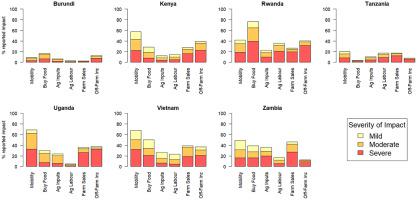Agricultural Systems ( IF 6.1 ) Pub Date : 2022-01-31 , DOI: 10.1016/j.agsy.2022.103367 James Hammond 1 , Kim Siegal 2 , Daniel Milner 1, 3 , Emmanuel Elimu 2 , Taylor Vail 2 , Paul Cathala 2 , Arsene Gatera 2 , Azfar Karim 2 , Ja-Eun Lee 2 , Sabine Douxchamps 3 , Mai Thanh Tu 1, 3 , Emily Ouma 1 , Ben Lukuyu 1 , Pius Lutakome 1 , Sonja Leitner 1 , Ibrahim Wanyama 1 , Trang Pham Thi 4 , Phan Thi Hong Phuc 4 , Mario Herrero 5 , Mark van Wijk 1

|
CONTEXT
The COVID-19 pandemic caused unprecedented global disruption and continues to wreak havoc. Dire predictions were made about the risks to smallholder farmers in lower- and middle- income, but hard data have been lacking. We present the results from 9201 interviews with smallholder farmers from seven countries.
OBJECTIVE
The objectives are to describe: i) how farmers perceive the key effects of the COVID-19 pandemic and containment measures on livelihoods and food security; ii) the effects on agricultural activities; iii) the coping strategies households deployed.
METHODS
Household surveys were conducted as part of ongoing monitoring programs during the latter half of 2020. Sites in seven countries were covered: Burundi; Kenya; Rwanda; Tanzania; Uganda; Zambia; and Vietnam. Findings are representative of smallholder farmers across multiple districts per country.
RESULTS AND CONCLUSIONS
The effects of the COVID-19 containment measures were widespread and often perceived to be severe. Food purchase, off-farm income, sale of farm produce, and access to crop inputs were all affected. In locations under more stringent restrictions during the time of the survey, up to 80% of households had to reduce food consumption and/or variety. Almost all households with off-farm incomes reported reductions, by half on average. A half to three-quarters of households (depending on the location) with income from farm sales reported losses compared to the pre-pandemic situation. In locations with more relaxed containment measures in place during the time of the survey, less frequent and less severe economic and food security outcomes were perceived by the respondent, with around 20% of households reporting negative outcomes. Mobility restrictions, reduced market access, crashes in sale price for agricultural goods, and soaring prices for food purchase were key factors. Sale prices generally dropped for all agricultural products in any given location, and affected not only high-value perishable products, but also staple crops such as maize and cassava. Depending on the location, between 30% and 90% of the households applied coping strategies in response to the pandemic during 2020. There was an almost complete absence of official aid amongst households interviewed.
SIGNIFICANCE
Our results raise the thorny issue of how best to balance containment of disease against the wellbeing of the vulnerable rural population in lower- and middle-income countries. There is a risk that the buffering capacity of rural people will become exhausted. Possible policy measures to limit negative outcomes include i) tiered mobility restrictions with travel allowed for economic reasons; ii) short-term price guarantee schemes to stabilise the food system; iii) direct aid; iv) the timely re-installation of distribution channels for agricultural inputs.
中文翻译:

COVID-19 限制对小农的感知影响:来自七个中低收入国家的证据
语境
COVID-19 大流行造成了前所未有的全球混乱,并将继续造成严重破坏。人们对中低收入小农面临的风险做出了可怕的预测,但一直缺乏确凿的数据。我们展示了对来自 7 个国家的 9201 名小农的采访结果。
客观的
目标是描述:i) 农民如何看待 COVID-19 大流行和遏制措施对生计和粮食安全的主要影响; ii) 对农业活动的影响; iii) 家庭采取的应对策略。
方法
作为 2020 年下半年持续监测计划的一部分,开展了家庭调查。覆盖了七个国家的地点:布隆迪;肯尼亚;卢旺达;坦桑尼亚;乌干达;赞比亚;和越南。调查结果代表了每个国家多个地区的小农。
结果与结论
COVID-19 遏制措施的影响广泛且通常被认为是严重的。粮食购买、非农收入、农产品销售以及农作物投入的获取均受到影响。在调查期间受到更严格限制的地区,高达 80% 的家庭不得不减少食品消费和/或品种。几乎所有非农收入家庭均报告减少了一半。与大流行前的情况相比,一半到四分之三的拥有农产品销售收入的家庭(取决于地点)报告称出现了损失。在调查期间采取较为宽松的遏制措施的地区,受访者感知到的经济和粮食安全结果的频率和严重程度较低,大约 20% 的家庭报告了负面结果。流动限制、市场准入减少、农产品销售价格暴跌以及食品采购价格飙升是关键因素。在任何特定地点,所有农产品的销售价格普遍下降,不仅影响高价值的易腐烂产品,还影响玉米和木薯等主要作物。根据地点的不同,30% 到 90% 的家庭在 2020 年采取了应对流感大流行的应对策略。受访家庭中几乎完全没有官方援助。
意义
我们的研究结果提出了一个棘手的问题,即如何最好地平衡中低收入国家疾病控制与弱势农村人口的福祉。农村人口的缓冲能力有耗尽的风险。限制负面结果的可能政策措施包括:i)分级流动限制,允许出于经济原因旅行; ii) 稳定粮食系统的短期价格保证计划; iii) 直接援助; iv) 及时重新建立农业投入品的分配渠道。











































 京公网安备 11010802027423号
京公网安备 11010802027423号